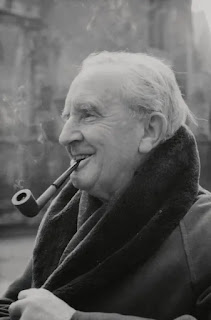 |
| Image credit: tolkienshop.com |
There are so many layers to adore in the makeup of an epic story. The fearless, flawed, or fiendish characters that fill the world and make the narrative spin. The beautiful, treacherous, and magnificent landscapes that house those characters, challenge them, or force them to undergo change. And the incredible, horrible, and mind-melting histories and lore that shapes and colours all.
It is a shame that lore can often be pushed to the backseat
in the carriage of a good story, because more often than not it is written in
such a boring and droning type of way that conflicts with the action going on
in the present. But for those of us that really love learning about why the
world is the way that it is, expositional chunks of lore are ecstasy. And I am still
buzzing from the thrill of reading quite possibly the most beautiful and
exciting ‘history’ book ever written: The Silmarillion.
Before Bilbo Baggins found a ring in a cave, before Frodo
Baggins took that ring on an epic quest that brought about the end of an Age,
and before a ranger from the North rose to be King of Gondor, there was Eru (Iluvatar)
who sang into being the Ainur who thus created the world. Many perfect and
beautiful things were thus brought into being, but none so perfect as the
Silmarilli: three perfect jewels fashioned by Feanor, most gifted of the Elves.
But such beauty and perfection brought also the dark seed of pride and envy, and
when the Silmarilli were stolen by the first Dark Lord, Morgoth, Feanor and his
kindred took up arms and waged a long and terrible war to recover them.
It is so very easy to become wrapped up in the epically
romantic and dramatic prose of J. R. R. Tolkien. It’s funny, both friends and
strangers alike upon discovering that I was reading The Silmarillion
were impressed and bemused. It seems the consensus is that the book is a long
and trying history book of a fictional world (it is) and peoples’ wonder at my
reading it so voraciously was akin to seeing someone read the dictionary or Ten Days That Shook the World for fun. All I have to say to this is that
history can be absolutely riveting if written in the right way!
 |
| Image credit: npg.org.uk |
Anyone who is a fan of The Hobbit and The Lord of the Rings needs to read The Silmarillion. From the origin stories, a
little reminiscent of Greek mythology, to the tragic Fall of Numenor, and then
the final chapter concerning the Rings of Power, this book is beautiful,
exciting, tragic, and epic!
Author: J. R. R. Tolkien, edited by Christopher Tolkien
(1977)
Published: Fist published in Great Britain by George
Allen & Unwin, 1977. Pictured edition published by HarperCollins Publishers,
London, 1999.
No comments:
Post a Comment